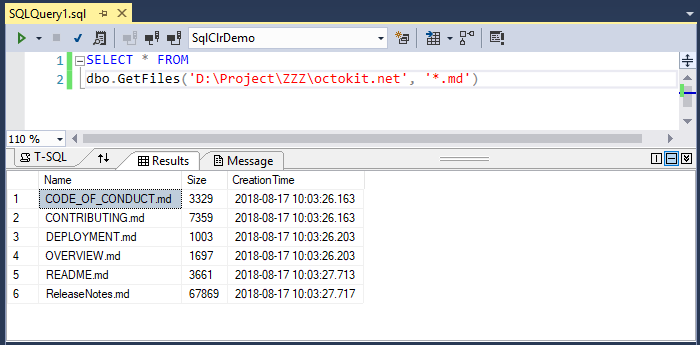SQL CLR CLR User-Defined Functions
A function is a procedure that returns a value or an object. It can take parameters, perform calculations or other actions, and return a result.
- You can write user-defined functions in any .NET Framework programming language, such as C# or VB.NET.
- The .NET functions typically return .NET types, and SQL CLR functions must return a type supported by SQL Server.
Types of User-Defined Functions
- CLR Scalar-Valued Functions
- CLR Table-Valued Functions
CLR Scalar-Valued Functions
A scalar-valued function (SVF) returns a single value, such as a string, integer, or bit value.
- The input parameters and the type returned from an SVF can be any of the scalar data types supported by SQL Server, except varchar, char, rowversion, text, ntext, image, timestamp, table, or cursor.
- SVFs must ensure a match between the SQL Server data type and .NET data type.
The easiest way to create a CLR scalar-valued function, select Project > Add New Item menu option.
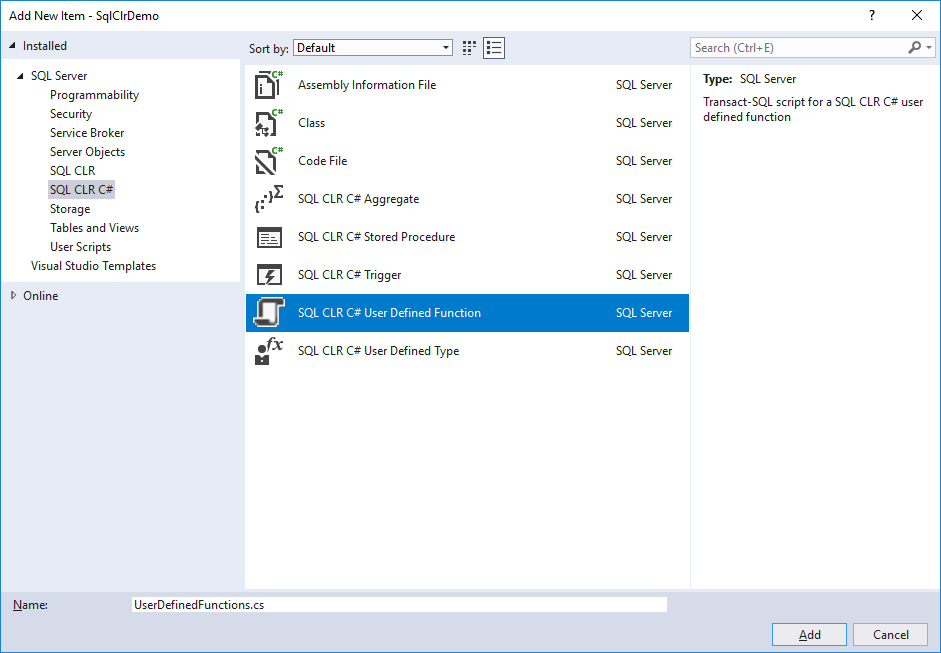
Select the SQL CLR C# from the list on the left pane, and choose SQL CLR C# User Defined Function in the middle pane. Let's add the following simple function which returns a string message.
public partial class UserDefinedFunctions
{
[Microsoft.SqlServer.Server.SqlFunction]
public static string ScalarUDF()
{
return "This is a CLR Scalar-Valued function";
}
}
The SqlFunction attribute is used for deployment of your SQL CLR functions. The following SQL statement will create a scalar-valued function.
CREATE FUNCTION dbo.ScalarUDF( )
RETURNS NVARCHAR (MAX)
AS EXTERNAL NAME SqlClrDemo.UserDefinedFunctions.ScalarUDF
CLR Table-Valued Functions
A table-valued function is a user-defined function that returns a table. SQL Server extends the functionality of table-valued functions by allowing you to define a table-valued function in any managed language.
- The SQL CLR table-valued functions (TVFs) are a little bit different from SQL CLR scalar-valued functions, or SQL CLR stored procedures.
- It must return a type that implements the .NET interface IEnumerable.
- TVFs must also provide a fill row method that converts an element of that type to a collection of scalar values that comprise the corresponding table row.
Let's create a very simple CLR Table-Value function which will search a given directory and returns a list of files information with names matching a search pattern. The FileData class will return the file name, size in bytes and its creation time.
private class FileData
{
public string Name;
public long Size;
public DateTime CreationTime;
public FileData(string fileName, long fileSize, DateTime creationTime)
{
Name = fileName;
Size = fileSize;
CreationTime = creationTime;
}
}
The 'GetFiles' method returns a list of FileData with names matching a search pattern.
[SqlFunction(FillRowMethodName = "FillRows", TableDefinition = "Name nvarchar(500), Size bigint, CreationTime datetime")]
public static IEnumerable GetFiles(string targetDirectory, string searchPattern)
{
try
{
ArrayList FilePropertiesCollection = new ArrayList();
DirectoryInfo dirInfo = new DirectoryInfo(targetDirectory);
FileInfo[] files = dirInfo.GetFiles(searchPattern);
foreach (FileInfo fileInfo in files)
{
FilePropertiesCollection.Add(new FileData(fileInfo.Name, fileInfo.Length, fileInfo.CreationTime));
}
return FilePropertiesCollection;
}
catch (Exception ex)
{
return null;
}
}
- The
FillRowMethodNameproperty is set to "FillRows". TheFillRowsmethod will be used to fill a row of data in the table returned by the function. - The
TableDefinitionproperty sets the structure of the table returned by a table-valued function. For example, this function will return the name of the file, its size in bytes and its creation time.
Here is code for FillRows method, it takes an object of the FileData type and breaks it into the file name, size and creation time.
private static void FillRows(object objFileProperties, out string fileName, out long fileSize, out DateTime creationTime)
{
FileData fileProperties = (FileData)objFileProperties;
fileName = fileProperties.Name;
fileSize = fileProperties.Size;
creationTime = fileProperties.CreationTime;
}
In Solution Explorer, right click on the project, and select Properties.
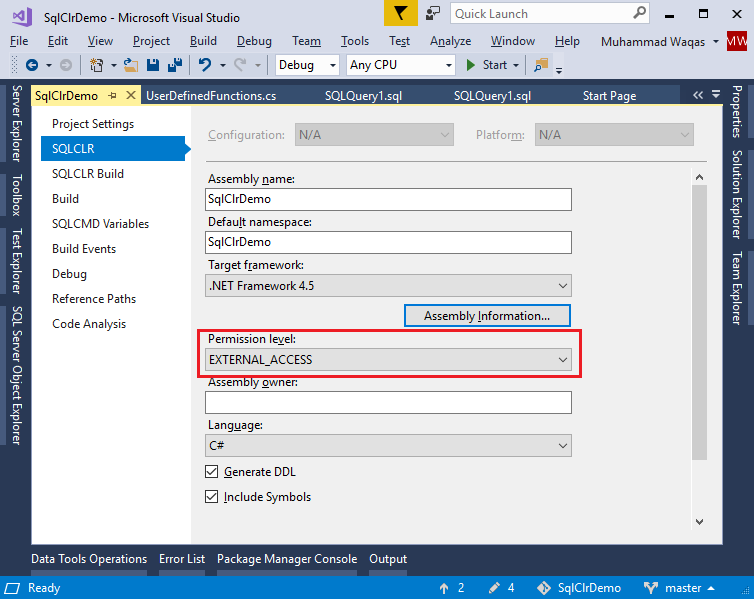
On the SQL CLR page set the Permission Level to EXTERNAL_ACCESS and then switch to Properties Settings page.
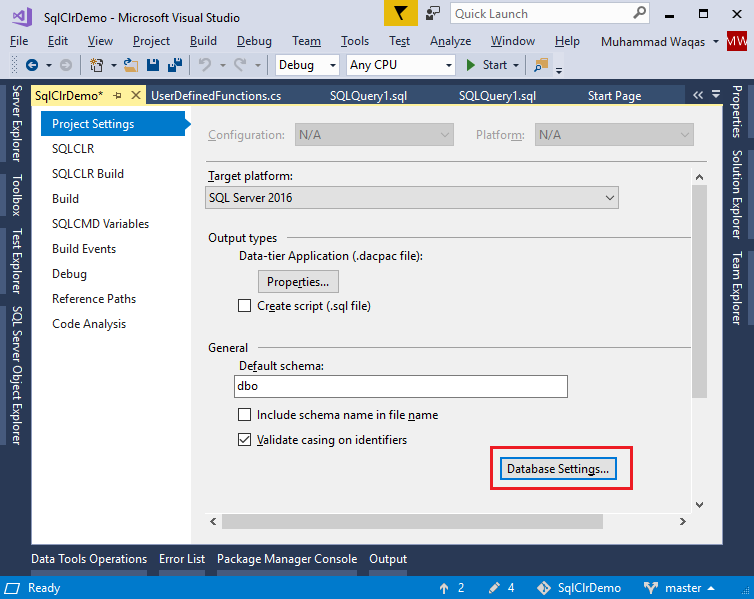
Click on the Database Settings... button and check the Trustworthy option.
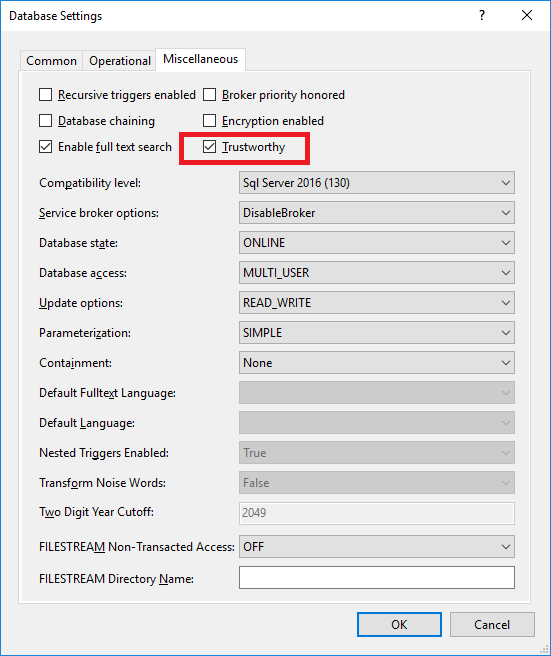
Let's execute the following SQL.
SELECT * FROM
dbo.GetFiles('D:\Project\ZZZ\octokit.net', '*.md')
Once it is executed, the Table-Valved function will return the list of files with *.md extension.
